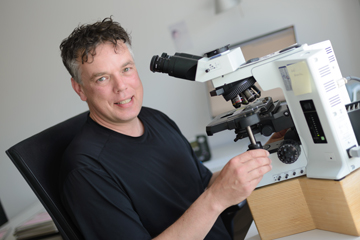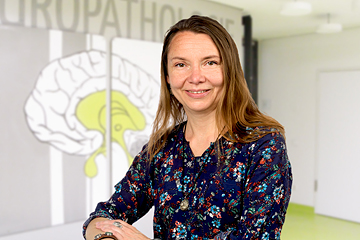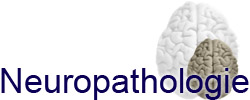Pediatric brain tumors: molecular pathology and mechanisms
Pediatric brain tumors are the second most common group of childhood cancers. Despite aggressive therapeutic approaches, the outcome of many children with brain tumors remains dismal. Little is known on targetable downstream pathways.
We aim at contributing to a better outcome in children with brain tumors. To this end, we are actively involved in improving and refining the neuropathological diagnosis of pediatric brain tumors. We also use animal and cell culture models in order to identify genetic alterations and signaling pathways involved in tumor biology. The clinical role of identified pathways is then confirmed in human tumor samples. One major focus of our lab is on atypical teratoid/rhabdoid tumors (AT/RT), highly malignant tumors mainly affecting young children.
Contact:
Martin Hasselblatt (Email)

Current projects
Clinical and molecular features predicting outcome in children with atypical teratoid/rhabdoid tumour (AT/RT)
Serving as reference neuropathology center for the European Rhabdoid Tumor Registry EU-RHAB, we are identifying clinical and molecular features predicting outcome in children with AT/RT and other tumors associated with SWI/SNF dysfunction. This project is done in close collaboration within an international network of pediatric neuroncologists, molecular geneticists and basic scientists.
Functional role and clinical relevance of mutated SMARCB1/INI1 protein in atypical teratoid/rhabdoid tumors (AT/RT)
AT/RT are characterized by mutations of the SMARCB1 gene, which encodes the SWI/SNF complex member SMARCB1/INI1. The outcome of AT/RT is usually dismal, but some patients also respond well to therapy and may even experience long-term survival. Molecular factors that might explain differences in biological tumor behavior remain to be identified. Preliminary findings from our group suggest that lower proliferative activity and longer overall survival in a subgroup of AT/RT could be explained by the presence of a truncated SMARCB1/INI1 protein, which might have residual function.
Within this DFG-funded project, Francesca Zin is systematically exploring the functional role and clinical relevance of mutated SMARCB1/INI1 protein in AT/RT. In particular, (1) we aim at a better understanding how various SMARCB1 mutations encountered in AT/RT affect SMARCB1/INI1 protein expression, (2) explore how the presence of mutated SMARCB1/INI1 proteins affects tumor biology and (3) investigate if the presence of mutated SMARCB1/INI1 proteins might explain the epigenetic and clinical heterogeneity of AT/RT. The results from this project will hopefully contribute to a better understanding of SMARCB1/INI1 protein function in AT/RT, but might also have implications for other tumors with SWI/SNF complex dysfunction. In the long term, they are expected to aid the development of prognostic markers and better treatment stratification for children with AT/RT (DFG: HA 3060/8-1)

Role of ASCL1 in the biology of atypical teratoid/rhabdoid tumors (ATRT)
Atypical teratoid/rhabdoid tumor (ATRT) is a highly malignant brain tumor predominantly arising in infants. Biallelic mutations of SMARCB1 are the characteristic genetic lesion. SMARCB1/INI1 is a member of the SWI/SNF chromatin remodeling complex, which is evolutionarily highly conserved and plays a critical role in cell differentiation and proliferation. However, little is known on alterations through which SMARCB1-deficiency drives oncogenesis across three recently identified molecular subgroups, i.e. ATRT-SHH, ATRT-TYR, ATRT-MYC. The majority of ATRT represents ATRT-SHH, a molecular subgroup characterized by overexpression of achaete-scute-complex-like 1 (ASCL1), a proneural gene originally identified in Drosophila melanogaster. Using a fruit fly model of SMARCB1-deficiency and human SMARCB1-deficient tumor cell lines, we already have been able to identify pathways and epigenetic alterations involved in the detrimental effects of SMARCB1-deficiency.
Taking advantage of these established models, Katarzyna Miskiewicz is aiming at a better understanding of the role of ASCL1 in the biology of ATRT-SHH. Within this IZKF-funded project, we hypothesize that SMARCB1-deficiency in ASCL1-expressing precursors may cause ASCL1 overexpression and disturbances of Notch signaling circuits operative in early nervous system development, thereby contributing to neural phenotype, tumorigenesis and detrimental outcome of ATRT-SHH. Within this project we are studying the consequences of knockdown of Snr1, the fly homologue of SMARCB1, in achaete/scute expressing proneural cells on achaete expression, proliferation, Notch and SHH signaling activity, and fly development. We also determine the specificity and sensitivity of ASCL1 protein expression for the diagnosis of ATRT-SHH as well as a potential prognostic role of ASCL1 protein expression in a large well characterized cohort of uniformly treated patients with known molecular subgroup status. The results are expected to further explain the functional role of ASCL1 in the biology of ATRT-SHH and to define a role of ASCL1 protein expression as a diagnostic and/or prognostic marker in ATRT. Our long-term goal is to improve the outcome of children with AT/RT (IZKF: Ha3/017/20).

Neuropathological and molecular characterization of rare SMARCB1-deficient tumors
In the context of the European Rhabdoid Tumor Registry EU-RHAB we also regularly see unusual tumors that do not readily fit into the WHO classification of central nervous system tumors. We are aiming at a better clinical, neuropathological and molecular understanding of such rare entities.
Examples include poorly differentiated chordoma with SMARCB1/INI1 loss, sellar region atypical teratoid/rhabdoid tumors in adults as well as AT/RT with molecular Features of Pleomorphic Xanthoastrocytoma. If you encounter an unusual SMARCB1-deficient tumor, you are most welcome to get in touch and send the case for consultation.
Selected publications
- Pathak R, Zin F. Thomas C, Bens S, Gayden T, Karamchandani J, Dudley RW, Nemes K, Johann PD, Oyen F, Kordes U, Jabado N, Siebert R, Paulus W, Kool M, Frühwald MC, Albrecht S, Kalpana GV, Hasselblatt M. Inhibition of nuclear export restores nuclear localization and residual tumor suppressor function of truncated SMARCB1/INI1 protein in a molecular subset of atypical teratoid/rhabdoid tumors. Acta Neuropathol 2021 142(2):361-374. https://doi.org/10.1007/s00401-021-02328-w
- Zin F. Cotter JA, Haberler C, Dottermusch M, Neumann J, Schüller U, Schweizer L, Thomas C, Nemes K, Johann PD, Kool M, Frühwald MC, Paulus W, Judkins A, Hasselblatt M. Histopathological patterns in atypical teratoid/rhabdoid tumors are related to molecular subgroup. Brain Pathol. 2021 Online ahead of print. https://doi.org/10.1111/bpa.12967
- Thomas C, Oehl-Huber K, Bens S, Soschinski P, Koch A, Nemes K, Oyen F, Kordes U, Kool M, Frühwald MC, Hasselblatt M. Siebert R. Transposable element insertion as a mechanism of SMARCB1 inactivation in atypical teratoid/rhabdoid tumor. Genes Chromosomes Cancer. 2021 60: 586-590. https://doi.org/10.1002/gcc.22954
- Thomas C, Federico A, Sill M, Bens S, Oyen F, Nemes K, Johann PD, Hartmann C, Hartmann W, Sumerauer D, Paterno V, Samii A, Kordes U, Siebert R, Frühwald MC, Paulus W, Kool M, Hasselblatt M. Atypical Teratoid/Rhabdoid Tumor (AT/RT) With Molecular Features of Pleomorphic Xanthoastrocytoma. Am J Surg Pathol. 2021 45:1228-1234. https://doi.org/10.1097/pas.0000000000001694
- Thomas C, Soschinski P, Zwaig M, Oikonomopoulos S, Okonechnikov K, Pajtler KW, Sill M, Schweizer L, Koch A, Neumann J, Schüller U, Sahm F, Rauschenbach L, Keyvani K, Proescholdt M, Riemenschneider MJ, Segewiß J, Ruckert C, Grauer O, Monoranu CM, Lamszus K, Patrizi A, Kordes U, Siebert R, Kool M, Ragoussis J, Foulkes WD, Paulus W, Rivera B, Hasselblatt M. The genetic landscape of choroid plexus tumors in children and adults. Neuro Oncol. 2020 23(4):650-660. https://doi.org/10.1093/neuonc/noaa267
- Thomas C, Wefers A, Bens S, Nemes K, Agaimy A, Oyen F, Vogelgesang S, Rodriguez FJ, Brett FM, McLendon R, Bodi I, Burel-Vandenbos F, Keyvani K, Tippelt S, Poulsen FR, Lipp ES, Giannini C, Reifenberger G, Kuchelmeister K, Pietsch T, Kordes U, Siebert R, Frühwald MC, Johann PD, Sill M, Kool M, von Deimling A, Paulus W, Hasselblatt M. Desmoplastic myxoid tumor, SMARCB1-mutant: clinical, histopathological and molecular characterization of a pineal region tumor encountered in adolescents and adults Acta Neuropathol 2020;139(2):277-286. https://doi.org/10.1007/s00401-019-02094-w
- Theruvath J, Sotillo E, Mount CW, Graef CM, Delaidelli A, Heitzeneder S, Labanieh L, Dhingra S, Leruste A, Majzner RG, Xu P, Mueller S, Yecies DW, Finetti MA, Williamson D, Johann PD, Kool M, Pfister S, Hasselblatt M. Frühwald MC, Delattre O, Surdez D, Bourdeaut F, Puget S, Zaidi S, Mitra SS, Cheshier S, Sorensen PH, Monje M, Mackall CL. Locoregionally administered B7-H3-targeted CAR T cells for treatment of atypical teratoid/rhabdoid tumors. Nat Med. 2020;26:712-719. https://doi.org/10.1038/s41591-020-0821-8
- Frühwald MC, Hasselblatt M. Nemes K, Bens S, Steinbügl M, Johann PD, Kerl K, Hauser P, Quiroga E, Solano-Paez P, Biassoni V, Gil-da-Costa MJ, Perek-Polnik M, van de Wetering M, Sumerauer D, Pears J, Stabell N, Holm S, Hengartner H, Gerber NU, Grotzer M, Boos J, Ebinger M, Tippelt S, Paulus W, Furtwängler R, Hernáiz-Driever P, Reinhard H, Rutkowski S, Schlegel PG, Schmid I, Kortmann RD, Timmermann B, Warmuth-Metz M, Kordes U, Gerss J, Nysom K, Schneppenheim R, Siebert R, Kool M, Graf N. Age and DNA methylation subgroup as potential independent risk factors for treatment stratification in children with atypical teratoid/rhabdoid tumors. Neuro Oncol. 2020 Jul 7;22(7):1006-1017. https://doi.org/10.1093/neuonc/noz244
- Ho B, Johann PD, Grabovska Y, Andrianteranagna MJD, Yao FP, Frühwald M, Hasselblatt M. Bourdeaut F, Williamson D, Huang A, Kool M. Molecular subgrouping of Atypical Teratoid / Rhabdoid Tumors (ATRT) - a reinvestigation and current consensus. Neuro Oncol. 2020;22:613-624. https://doi.org/10.1093/neuonc/noz235
- Hasselblatt M. Thomas C, Nemes K, Monoranu C, Riemenschneider MJ, Koch A, Sumerauer D, Hauser P, Paulus W, Johann PJ, Kool M, Frühwald MC. Tyrosinase immunohistochemistry can be employed for the diagnosis of atypical teratoid/rhabdoid tumours of the tyrosinase subgroup (ATRT-TYR). Neuropathol Appl Neurobiol 2020;46:186-189. https://doi.org/10.1111/nan.12560


